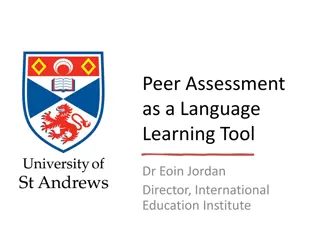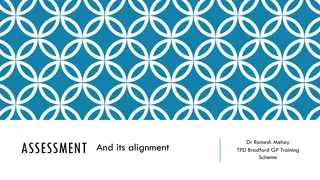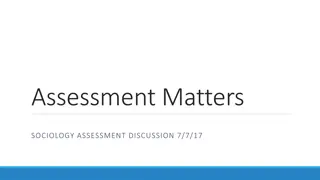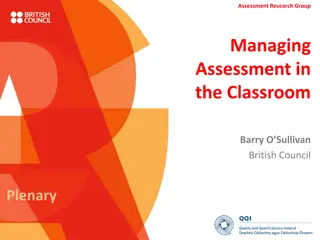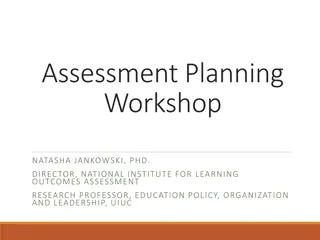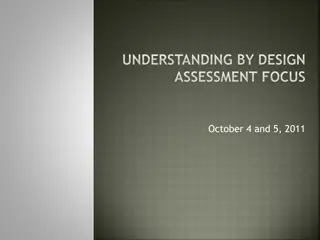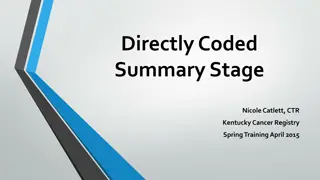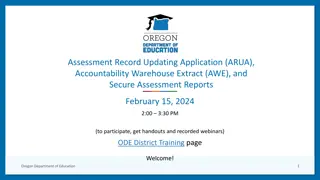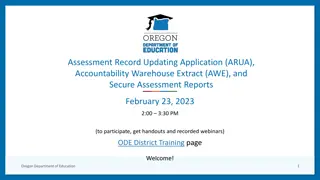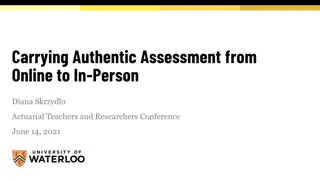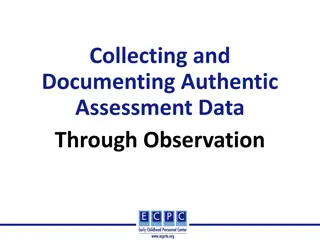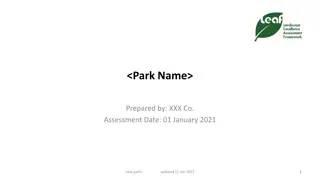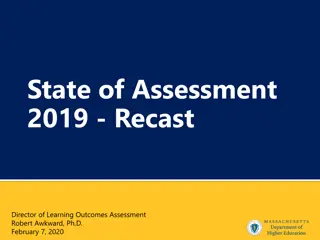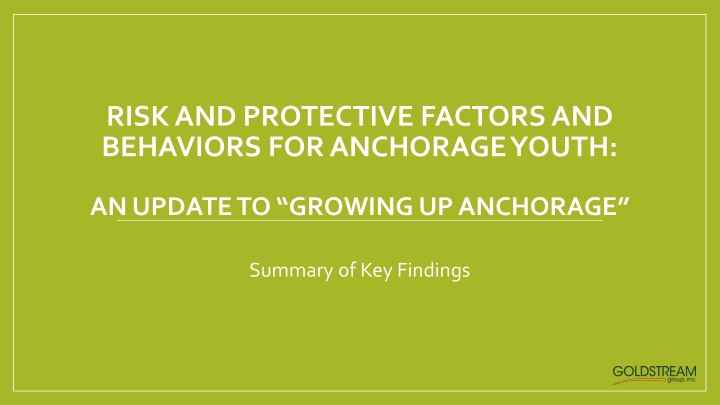
Update on Risk and Protective Factors for Anchorage Youth
Gain insights into the current status, trends, and correlations of risk and protective factors among Anchorage youth, based on a comprehensive assessment. Explore how these factors impact behaviors and discover significant relationships highlighted in the data analysis.
Download Presentation

Please find below an Image/Link to download the presentation.
The content on the website is provided AS IS for your information and personal use only. It may not be sold, licensed, or shared on other websites without obtaining consent from the author. If you encounter any issues during the download, it is possible that the publisher has removed the file from their server.
You are allowed to download the files provided on this website for personal or commercial use, subject to the condition that they are used lawfully. All files are the property of their respective owners.
The content on the website is provided AS IS for your information and personal use only. It may not be sold, licensed, or shared on other websites without obtaining consent from the author.
E N D
Presentation Transcript
RISK AND PROTECTIVE FACTORS AND BEHAVIORS FOR ANCHORAGE YOUTH: AN UPDATE TO GROWING UP ANCHORAGE Summary of Key Findings
What is the current status of the identified risk and protective factors and risk behaviors among Anchorage youth? Are there trends in risk and protective factors and risk behaviors among Anchorage youth, and which trends are most significant? What correlations currently exist between risk and protective factors and risk behaviors among Anchorage youth, and what are the most significant correlations? Guiding Questions for Conducting the Assessment
Comparison of Protective Factors from 2009 to 2017 for Anchorage School District High School Students (Alaska Youth Risk Behavior Survey)
Comparison of Risk Factors and Behaviors from 2009 to 2017 for Anchorage School District High School Students (Alaska Youth Risk Behavior Survey)
16 Risk and Protective Factors Youth Mattering Youth Feel Alone Teachers Care and Give Encouragement School has Clear Rules and Consequences Comfortable Seeking Help from 3+ Adults Parents Talk about School Perceived Risk of Alcohol Use Friend Perception of Alcohol Use Parent Perception of Alcohol Use Bullying Electronic Bullying Dating Violence Felt Unsafe at School Where Students Sleep Participation in Organized Activities/Volunteering Physical Activity Were cross tabulated with 11 risk behaviors: 30-day Alcohol Use Binge Drinking 30-day Marijuana Use 30-day Vaping Seriously Considered Suicide Felt Sad or Hopeless Carried a Weapon Was in a Physical Fight 30-day Rx Pain medicine Use 30-day Heroin Use 30-day Meth Use Cross tabulations used 2017 Youth Risk Behavior Survey (YRBS) data for all ASD high school students
Of the 176 cross tabulations of risk and protective factors with risk behaviors: Using a Pearson Chi-Square Value of <.001, 163 of the 176 cross tabulations of risk and protective factors with risk behaviors were statistically significant. 163 had a statistically significant relationship with a P-Value <.001 154 had a relationship that would be expected (a protective factor decreased the likelihood for a risk behavior, or a risk factor increased the likelihood for a risk behavior) 9 had a relationship that was the reverse of what would be expected (the presence of a protective factor correlated with an increase in the risk behavior). The protective factors impacted were physical activity and participation in organized activities/volunteering. (165 would be considered statistically significant if a P- Value of <.05 were used instead) Of the 16 risk and protective factors evaluated: 10 had a statistically significant correlation with all 11 risk behaviors, where the presence of a protective factor decreased the risk behavior and the presence of a risk factor increased the risk behavior
Statistically Significant Correlations between Risk and Protective Factors and Risk Behaviors where Yes Denotes a P-Value <.001 (2017 Alaska Youth Risk Behavior Survey for all ASD high school students) 30-day Methamphetamine Use Seriously Considered Suicide 30-day Rx Pain Medicine Use Was in a Physical Fight 30-day Marijuana Use Felt Sad or Hopeless 30-day Alcohol Use 30-day Heroin Use Carried a Weapon Binge Drinking 30-day Vaping Risk or Protective Factor Youth Mattering Youth Feel Alone in their Life Teachers Really Care and Give Encouragement School Has Clear Rules and Consequences Comfortable Seeking Help from 3+ Adults Parents Talk to them about School Perceived Risk of Alcohol Use Friend Perception of Alcohol Use Parent Perception of Alcohol Use Bullying Electronic Bullying Dating Violence Felt Unsafe at School Where Students Sleep Participated in Organized Activities/Volunteered Physical Activity *There was a statistically significant correlation, but the correlation was the reverse of what would be expected (i.e. the protective factor resulted in a statistically significant increase in the risk behavior) **Pearson Chi-Square Value was > .001 but < .05, and may be considered statistically significant in other studies Yes Yes Yes Yes Yes No Yes Yes Yes Yes Yes Yes Yes Yes No Yes* Yes Yes Yes Yes Yes No Yes Yes Yes Yes Yes Yes Yes Yes No Yes* Yes Yes Yes Yes Yes No Yes Yes Yes Yes Yes Yes Yes Yes Yes Yes* Yes Yes Yes Yes Yes Yes Yes Yes Yes Yes Yes Yes Yes Yes No Yes* Yes Yes Yes Yes Yes Yes No Yes Yes Yes Yes Yes Yes Yes Yes Yes Yes Yes Yes Yes Yes Yes No Yes Yes Yes Yes Yes Yes Yes Yes Yes Yes Yes Yes Yes Yes Yes Yes Yes Yes Yes Yes Yes Yes Yes No Yes* No Yes Yes Yes No Yes Yes Yes Yes Yes Yes Yes Yes Yes No** Yes* Yes Yes Yes Yes Yes Yes Yes Yes Yes Yes Yes Yes Yes Yes Yes* No** Yes Yes Yes Yes Yes Yes Yes Yes Yes Yes Yes Yes Yes Yes Yes* Yes Yes Yes Yes Yes Yes Yes Yes Yes Yes Yes Yes Yes Yes Yes Yes* Yes
Correlations of Protective Factors on Selected Risk Behaviors (2017 Alaska Youth Risk Behavior Survey for All ASD High School Students) ASD high school students who agree that in their community they feel like they matter to people were 51.2% less likely than those who do not ASD high school students who feel comfortable seeking help from 3+ adults besides their parents were 59.3% less likely than those who do not ASD high school students who disagree that they feel alone in their life were ASD high school students who agree that their teachers really care and give a lot of encouragement were 37.2% less likely than those who do not ASD high school students who agree their school has clear rules and consequences were 39.9% less likely than those who do not ASD high school students whose friends feel it is wrong to have 1 or 2 alcohol drinks nearly every day were 30.0% less likely than those who do not ASD high school students whose parents feel it is wrong to have 1 or 2 alcohol drinks nearly every day were 29.1% less likely than those who do not 72.1% less likely than those who do not to report they seriously considered attempting suicide in the past 12 months. to report they felt so sad or hopeless for 2 weeks or more in a row in the past 12 months that they stopped doing some of their usual activities. 42.3% less likely than those who do not 51.6% less likely than those who do not 61.2% less likely than those who do not 34.0% less likely than those who do not 34.6% less likely than those who do not 31.5% less likely than those who do not 31.1% less likely than those who do not 27.5% less likely than those who do not 34.9% less likely than those who do not 21.8% less likely than those who do not 22.6% less likely than those who do not 20.3% less likely than those who do not 22.5% less likely than those who do not 34.4% less likely than those who do not 42.7% less likely than those who do not 34.5% less likely than those who do not 34.2% less likely than those who do not 40.9% less likely than those who do not 52.6% less likely than those who do not 45.0% less likely than those who do not 69.8% less likely than those who do not to report they had at least one drink of alcohol in the past 30 days. to report they binge drank in the past 30 days.


